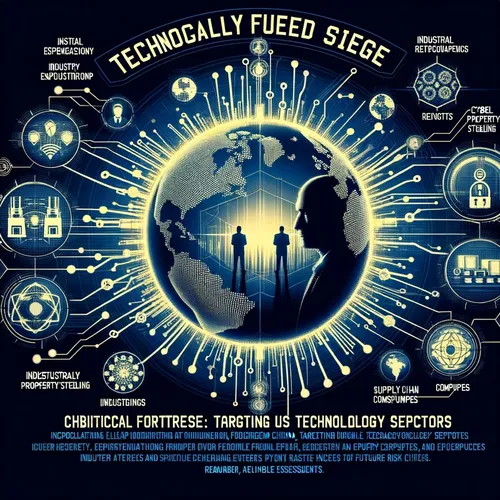Silicon Siege: China's Cyber Crossfire Scorches US Tech Sector
- Author
- Quiet. Please
- Published
- Mon 25 Aug 2025
- Episode Link
- https://www.spreaker.com/episode/silicon-siege-china-s-cyber-crossfire-scorches-us-tech-sector--67509916
This is your Silicon Siege: China's Tech Offensive podcast.
Hang tight, listeners! It’s Ting, your cyber oracle, coming at you with the latest from the digital trenches. If you blinked these last two weeks, you probably missed China’s latest Silicon Siege against the US tech sector—a crossfire of bytes, supply chain worries, and some scandalous undercover ops.
Let’s kick things off with Google’s recent red alert: their Threat Intelligence team flagged UNC6384, a China-affiliated hacker group, that cooked up malware disguised as software updates targeting diplomats—classic social engineering, but with an extra spicy twist. Patrick Whitsell, Google’s resident security whiz, reported about two dozen victims installed this malware, likely crafted to exfiltrate sensitive diplomatic docs. And Whitsell didn’t mince words: attackers might be government agents or outside contractors, but they operated like pros, leveraging compromised Wi-Fi to slip their Adobe plugin imposter right into memory, completely dodging antivirus nets.
Speaking of plug-ins and espionage, the FCC just threw down the cyber gauntlet by shutting China out of America’s undersea cable networks. If you weren’t worried about supply chain vulnerabilities before, listen up: these cables carry 95% of our international data. The FCC now bars Chinese equipment and contractors—think HMN Technologies—from even sniffing US shores. Nikkei Asia notes the new rules mean stricter audits, delays up to 30%, and a frantic scramble by Google and Meta to reroute their cable deals. One industry expert told Reuters it’s all about “exploitation risks,” particularly after discoveries of Chinese patents designed for deep-sea sabotage. Who knew the next big hack might come from a submarine?
Meanwhile, CrowdStrike’s experts have been tracking Murky Panda—aka Silk Typhoon. This not-so-cuddly group has targeted everything from government agencies to tech giants, breaching US cloud environments by exploiting weak points like the Citrix NetScaler ADC zero-day vulnerability. Once inside, Murky Panda sets up shop using stealthy malware like CloudedHope and web shells such as Neo-reGeorg, pivoting deep into trusted SaaS environments and making off with digital gold. David Hollingworth likens their strategy to a chess grandmaster—outthinking most defenders with clever lateral moves.
Of course, it isn’t just outsiders stirring chaos. Davis Lu, a Chinese software developer in Houston, was convicted for planting a brutal kill-switch in the network of his Ohio employer. When Lu was fired, the switch activated and locked out thousands of users, costing the company hundreds of thousands in losses. Prosecutors said Lu’s sabotage showed the devastation a lone insider can inflict, especially when skilled and bitter.
Data I/O—the electronics supplier to giants like Amazon, Apple, and Google—suffered a ransomware attack mid-August, knocking out internal comms, manufacturing, and support ops. While details on a China link are thin, the timing, target, and signature disruption tactics fit recent trends spotlighted by security analysts.
Industry experts are nearly unanimous: US tech sectors face mounting threats—not just from sophisticated hackers like Murky Panda or UNC6384, but from systemic supply chain exposures and well-placed insiders. The strategic implications echo far beyond loss balance sheets; they threaten intellectual property, trust in global commerce, and national resilience.
So, what’s next on the battlefield? Expect regulators to keep tightening controls, tech titans to spend even more on cyber defense, and hackers to keep evolving. The Silicon Siege won’t lift soon.
Thanks for tuning in! Smash that subscribe button so you never miss the next byte of cyber intrigue. This has been a quiet please production, for more check out quiet please dot ai.
For more
